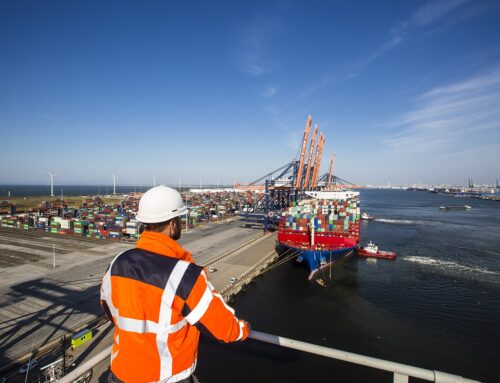The electronics supply chain, for the past year, has been marked by component shortages, lead-time extensions and tariff uncertainties. Nevertheless, it’s been a good year for component manufacturers and distributors—many of which have reported record quarterly sales during 2018. In 2019, IDC projects, the supply chain writ large is poised to transition from a cost center to an “opportunity center” as digital transformation accelerates.
“If you go back—and I’ve been in the supply chain for a long time—one of the shifts I have seen in recent years is the supply chain is no longer about the lowest cost,” said Simon Ellis, IDC program vice president for global Supply Chain Strategies. “The challenge has been ‘How do I do what I do as inexpensively as possible?’ Now we have moved into the digital era where [the supply chain’s task] is to deliver to customers’ expectations. That’s where we see opportunity.”
Computer manufacturer Dell first viewed the supply chain as a competitive advantage back in 1997. IDC characterizes 2018 as a year of transition where old, analog processes were replaced by digital. “Digital transformation (DX) was the key overriding theme and will continue to be for 2019,” Ellis said, “but the supply chain is increasingly viewed by manufacturers and retailers as a critical function for their future success. If companies are going to embrace new business models, or digitally enable older ones, they are going to need a modern, capable supply chain to do it.”
Predictions for 2019 IDC’s center around expansion in the use of AI, data, automation and networking.“The supply chain continues on its journey of almost unparalleled levels of change,” said Ellis. “Digital transformation is now the overriding priority for most manufacturers and retailers, with the adoption of digital technologies aimed at improving efficiency and effectiveness as well as providing the opportunity to either disrupt their market segment or be resilient to others that may try.”
IDC’s predictions for 2019 are:
- By 2024, more than 60 percent of G2000 manufacturing organizations will rely on artificial intelligence platforms to drive digital transformation across the supply chain, leading to productivity gains of more than 20 percent.
- By 2022, more than 40 percent of manufacturers worldwide will be integrating data from product life-cycle apps into their supply chain data to improve overall after-sales service levels, achieving increases of 60 percent.
- By 2020, 65 percent of ecommerce operations will make use of autonomous mobile robots within their order fulfillment processes, thus helping increase productivity by more than 100 percent.
- By 2021, smart supplier life-cycle management solutions will automate 50 percent of suppliers’ enterprise activities, from onboarding to exit, thus improving both performance and relationships.
- By 2024, one-third of large manufacturers will have moved to using actual demand data instead of short-term forecasts, resulting in an on-time in full (OTIF) delivery improvement of 2 percentage points on average.
- By 2020, half of the large manufacturers will have begun shifting their supply chain applications from enterprise centric to network centric, driving productivity gains of 2 percentage points.
- By 2022, digital technologies will have enabled the automation of repetitive operational tasks, leading to 50 percent less planner intervention and “touchless” sales and operations planning.
- By 2023, talent shortages in the supply chain for 75 percent of the top 500 manufacturers worldwide will largely have been mitigated using supply chain digital assistants.
- By 2019, 25 percent of manufacturers will have doubled investments in distribution automation in reaction to dramatic increases in single-item orders originating from the growth of online marketplaces.
- By 2020, track-and-trace investments will have increased by 30 percent to improve forecast accuracy and customer experience metrics and real-time order visibility will have become the norm for consumers.

IDC Global Supply Chain VP Simon Ellis
Several of these transitions will significantly benefit the electronics supply chain, which is distinguished by its complexity and inexact forecasting. “In Prediction 5, the idea is that short-term forecasting is hard to do—some industries have done it well and others poorly,” said Ellis. “So, as we get more visibility into consumption – at the store or other points of sale (POS)—we are able to measure real demand rather than predict demand.”
Ellis acknowledges that manufacturing lead times for electronics components, which average 18 weeks, remain problematic. In this case, he said, businesses should focus on medium- to long-term forecasts that provide useful information. “The fact that customers often buy products in a Tuesday doesn’t have much of an impact,” said Ellis. “Lead times, to a degree, dictate where consumption information is useful.”
Suppliers manufacturing products sold to a variety of customers can leverage this type of data to enhance the ability to remain flexible and responsive to changing customer demands. “Let’s say I manufacture hard drives but I haven’t put them in a case yet,” Ellis explained. “I postpone the final configuration until the last moment when I know whether the product is going into a smart phone or a tablet.”
Even the most complex supply chains can be evolved into opportunity centers, Ellis said. Electronics companies that continue to automate warehousing can increase order accuracy while cutting costs.
“The question I get more than any other is, in an industry where we’ve dealt with full pallets and truck loads for 50 years, how do we face the prospect of selling a single item to directly to a consumer? And how do you do that economically?” said Ellis.
“Our feeling is that those tasks are well serviced by robots. For an industry such as electronics distribution where a distributor buys from manufacturers and breaks down small orders and maybe ships them the same day, robots are optimal for any business that has to facilitate that kind of fulfillment.”
Source: https://epsnews.com/2018/12/06/global-supply-chain-2019/




